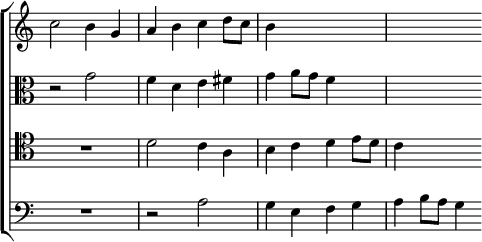267. We lastly give the closest possible stretto in four parts.

Here the entries are regular both as regards time and interval, each succeeding voice being introduced half a bar later, and a fourth below the preceding one. It will be noticed that in each voice the subject is carried down to the same point.
268. We have now given more than twenty stretti on the same subject, of which we have by no means exhausted the possibilities. It is probable that, by using all the combinations in three and four parts at the various distances of time and entry, we might make at least forty or fifty stretti on this subject. The student may not unnaturally be inclined to ask, What is the difference in character between this subject and the one worked in § 247; and how is it that so few good stretti could be obtained from the one, and so many from the other? The explanation is very simple. We said in § 247 that a subject intended for stretto should be expressly designed for that purpose. The best and easiest way of so designing it is, to write it in the first instance as a canon in the fourth or fifth at the shortest distance at which it is intended ultimately to be introduced. In the present instance we began by composing the little canon seen at § 259 (a), as far as the first note of the fourth bar. We then completed the subject by the addition of the notes—

The entries at longer distances were then found by experiment—trying to fit the answer against the subject, or the subject against itself, at all possible intervals and distances of entry. It will nearly always be found that subjects which, like this one, work in close stretto, can also be employed at longer distances.
269. The stretto is mostly met with in the middle and final sections of a fugue, of which we shall speak in the next chapter; but when the fugue has a counter-exposition, the first stretto (as already mentioned in § 209) is frequently introduced at that point. A good illustration of this is seen in the 33rd fugue of the 'Wohltemperirtes Clavier.' We quote the exposition and the counter-exposition.
